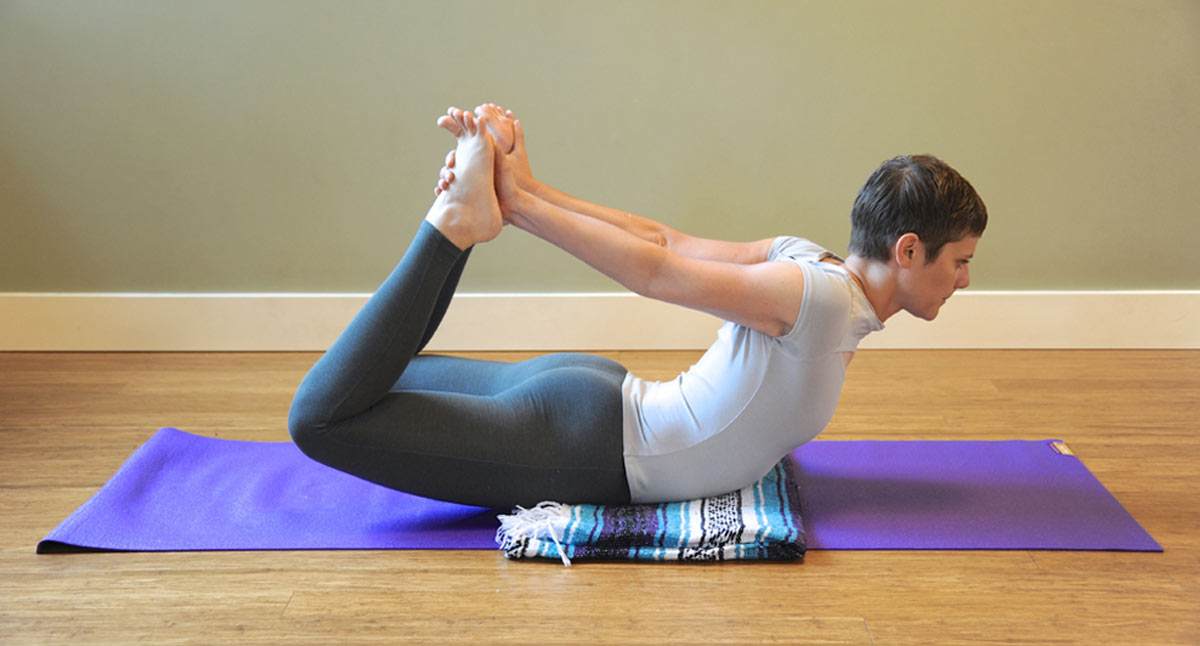
Over the centuries, the bow and arrow has symbolized everything from birds in flight to a phallus to the path of a sadhu, the most direct and efficacious route to enlightenment. A bow’s combination of tautness and flexibility is a metaphor for the Indian philosophy of balance in the Universe. Plato said, “The harmony of the ordered world is one of contrary tensions, like that of the harp or bow.”
In Patanjali’s Yoga Sutras, Sutra 2.46, the first of three that describe the physical practice of asana, says “The physical body should be steady and comfortable.” The mindful practice of finding equilibrium between strength and flexibility defines the art of yoga—as my teacher Pujari said of a balanced approach to practice, “not too tight, not too loose.”
Every single yoga pose embodies the qualities of firmness and softness. Each one presents a unique situation in which to explore equilibrium. Dhanurasana (Bow Pose) is just one example of each asana’s capacity to express strength, flexibility, grounding and opening.
Dhanurasana stretches the entire front body from the ankles to the throat as it strengthens back muscles and helps to counter hunched “computer shoulders.” It stimulates abdominal organs and can relieve constipation, respiratory conditions, fatigue and anxiety. Like all prone backbends, it strengthens the muscles of the back. Proceed with caution if you have high or low blood pressure, insomnia, back or neck injuries or suffer from migraines.
How to Practice Dhanurasana
Because Dhanurasana stretches the entire front body, it is good to warm up with poses that stretch the quadriceps, hip flexors and shoulders. Anjaneyasana and Supported Matsyasana are perfect warmups for Dhanurasana. In addition to its quad-stretching ability, Anjaneyasana (Lunge) also embodies grounding and buoyancy. Supported Matsyasana gently expands the front torso.
- Begin by lying face down on a nonskid yoga mat. I like to place a folded yoga blanket under my hipbones so that they don’t grind into the floor.
- Because grounding is the foundation for expansion, begin by establishing this relationship in a simpler pose. Clasp your hands behind you so that your hands rest on your buttocks. Roll your shoulders back and slide your shoulder blades down your back. Press your hipbones into your blanket or mat, allowing your legs and chest to rise up. Stretch back through your arms to expand your chest.
- Place your head and neck in a neutral position, neither throwing it back nor letting it sag down. Lengthen the back of your neck so that the front and back of your neck are stretching evenly. You will be looking at the floor.
- Take 5 to 10 breaths into your abdomen, allowing your body to lift a bit on your in breath, and release on your out breath. Then relax down onto the floor and turn your head sideways to rest. You can repeat this a few times if you like before moving to Dhanurasana.
- For Dhanurasana, begin lying prone on the floor. Bend your knees, reach your hands back and grab your ankles or the tops of your feet. As in the pose above, ground your pelvis, allowing the legs and chest to rise.
- Breathe deeply into your abdomen, actively descending your abdomen on the inhalation as your upper body and legs rise. Look straight ahead so that the back of your neck stays long and your head feels neutral. Feel your body oscillating in rhythm with your breath.
- Take 5 to 10 deep breaths. Release your ankles and come to rest on your belly, turning your head to one side. Make sure to alternate turning your head to the other side each time you repeat the pose.
- If your hands don’t reach your feet yet, you can use a yoga strap to connect them. Place the strap under your legs in a “U” shape with the bottom of the “U” at your ankles and the sides of the “U” extending alongside your legs. The ends of the strap should be on either side of your pelvis or waist, depending on the length of your strap. Move into the pose as above, but instead of holding your ankles, grab the strap and draw your ankles toward your head. You can walk your hands back on the strap toward your ankles so that your arms are straight, like a bowstring.
Make It Playful
Here’s a favorite variation: While you’re in Dhanurasana, roll onto your right side, still holding your ankles. Take a few deep breaths and then roll onto your left side. Roll side to side, taking a few deep breaths on each side.
In Dhanurasana, your chest, abdomen and quads must be supple while the abdomen is simultaneously strongly rooted. The arch of the bow (the front body) is flexible, while the string (the arms) is taut. In her wonderful book, Downward Dogs & Warriors, Zo Newell recounts the story of shape-shifting Shiva and his archery lesson to Arjuna, hero of the Bhagavad Gita. She says Shiva’s bow is a “symbol of divine power that can become available to us if we prepare ourselves how to handle it.” Practiced with a balanced attitude, Dhanurasana can unleash your divine potential.

Amazing article. Very well explained. Dhanurasana is one of those yoga poses which is difficult to execute perfectly and is injury-prone. This article is gonna help in making it easy.